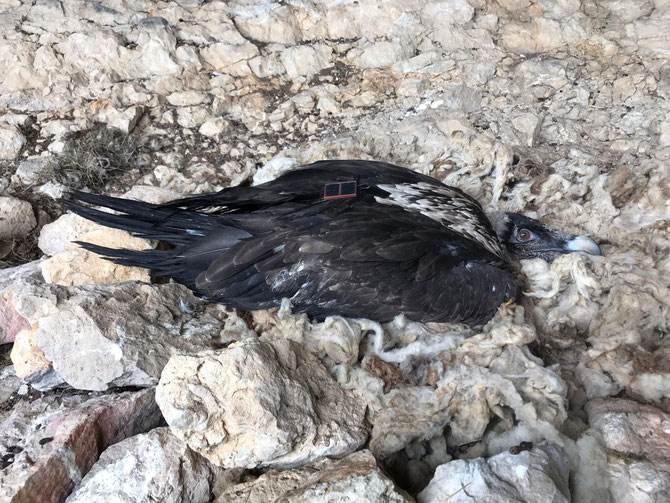
A Bearded Vulture named Transhumancia that had been reintroduced in Andalusia paid a brief visit to Portugal in May, making it the ninth record of a Bearded Vulture in Portugal in the last 100 years! Transhumancia was released in Cazorla last year as part of the collaborative reintroduction project in Andalusia, Spain, carried out by the Junta de Andalucía and the Vulture Conservation Foundation (VCF).
Recent records of Bearded Vultures in Portugal
The Bearded Vulture used to breed in Portugal centuries ago, but it is now considered extinct in the country. There were no official records of the occurrence of the species since the end of the 19th Century, according to the book ‘Aves de Portugal’ (Birds of Portugal 2010).
Transhumancia was not the only Andalusian Bearded Vulture that visited Portugal. Bearded Vulture Rayo hatched in the VCF’s Vallcalent Specialised Breeding Centre in Lleida and was released on 31 May 2014 as part of the same reintroduction project in Andalusia. On 6 and 7 May 2018, Rayo was spotted and photographed in the Algarve, Southern Portugal. This event was exciting for sure, as Rayo was the first photographed Bearded Vulture in the country in the past 100 years!
Before Rayo was photographed, at least three Bearded Vultures from the Andalusia reintroduction project have passed quickly through Portugal, but they have not been observed or photographed there – same happened with Transhumancia.
Transhumancia entered Portugal over Malcata, then moving to Estrela mountain, and westwards to Viseu, passed near Oporto, up to Braga, and stopped over in Geres National Park – where more than 100 years ago the species bred. It then continued to Galicia. After its short visit to Portugal, Transhumancia travelled to Madrid, Spain. Transhumancia hatched at Natur- und Tierpark Goldaulast year and was released on 24 May in Cazorla’s hacking cave.
There is probably little food nowadays in Portugal for this species, even though in Gerês National Park the Iberian wild goat is now thriving, following a successful reintroduction project – bearded vultures only eat parts of dead animals, but they have a strong preference for goat bones. With the Andalusian population on the rise, it is very likely that more bearded vultures will wander into Portugal – so keep scrutinizing those vulture silhouettes in the sky!
Bearded Vulture reintroduction in Andalusia

Bearded Vultures went extinct in Andalusia in 1986 mainly due to direct persecution, wildlife poisoning and human disturbance at the nesting sites. To bring them back, Junta de Andalucía, and us here at the Vulture Conservation Foundation (VCF) started a reintroduction project in 1996, and the former Fundación Gypaetus was also created to manage the project. Since the first releases in 2006 and with the release of eight individuals this year, 71 Bearded Vultures will be released in Andalusia by July this year in the provinces of Jaén and Granada. Thanks to tackling threats and releasing birds, the population of the species is gradually increasing. There are currently three Bearded Vulture pairs and 43 confirmed individuals in Andalusia. Hopefully, the chicks that hatched in the wild this season will survive and also stay in the region.
Below you can see the movements during May of released Bearded Vultures in Andalusia.
You can stay tuned with the releases by tracking #BeardedVultureReleaseSeason on Facebook, Twitter, LinkedIn and Instagram!

























